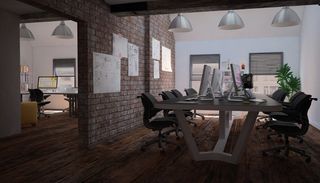10 tips for creating a 3D virtual studio
Discover what Corporation Pop learned from using Unity 5 to create a VR replica of its Manchester design studio.
Creating 3D art is no easy feat. In particular, mastering a realistic environment in 3D is a big challenge given the numerous factors that affect 'realism' in a given scene – lighting, texturing, mesh detail and scale are all equally important. However, trying to recreate realism in a game engine is a whole different territory.
Corporation Pop recreated its design studio in Manchester as a 3D virtual environment in Unity 5, allowing the team to try out some of the platform's latest features.

Here are Corporation Pop's top 10 tips on how to create your office or studio as an online 3D world:
01. Pick your engine
Physically based shaders differ between engines so work with a specific engine in mind. Your PBR textures will most likely need tweaking to look good in Unity.
02. Research
For an architectural visualisation, try to get the building plans or make them. Take reference photos, record films, observe the real world, which will help once you start modelling.
03. Scale is key
No matter how realistic your models and textures are, if the scale is not realistic everything will look off. What seems fine on your screen, may look weird in VR.
04. Less is more
A few good props are better than hundreds of mediocre ones. Baking takes longer with a scene full of objects. You can always add more later.
05. VR is something different
To go VR you're likely to need to change a lot or start from scratch as things won't look right once you’re 'in the scene'.
06. Forums are your friend
If you run into problems, forums are your best bet. Even if there is no fix yet, someone may solve it for you or recommend a product.
07. Iterate
If you feel something in your scene is not quite right, don't be afraid to start again as it can be faster than trying to fix it.
08. Try different tools
There is no one way of creating a model or a texture. New software, plugins and resources are released every day so keep researching and trying things.
09. Don’t build what you can’t see
For "walk through" visualisations, consider your audience's viewpoint. Approach it like you were building a film set. This will greatly increase performance.
10. Occlusion culling is vital
The inside of buildings usually have lots of separate spaces. You will improve performance by not rendering objects that aren’t in the camera’s field of view.
Related articles:
- Get the best, free resume templates
- Why not grab some of these amazing free 3D models?
- Stunning examples of geometric patterns

Thank you for reading 5 articles this month* Join now for unlimited access
Enjoy your first month for just £1 / $1 / €1
*Read 5 free articles per month without a subscription

Join now for unlimited access
Try first month for just £1 / $1 / €1
Get the Creative Bloq Newsletter
Daily design news, reviews, how-tos and more, as picked by the editors.
